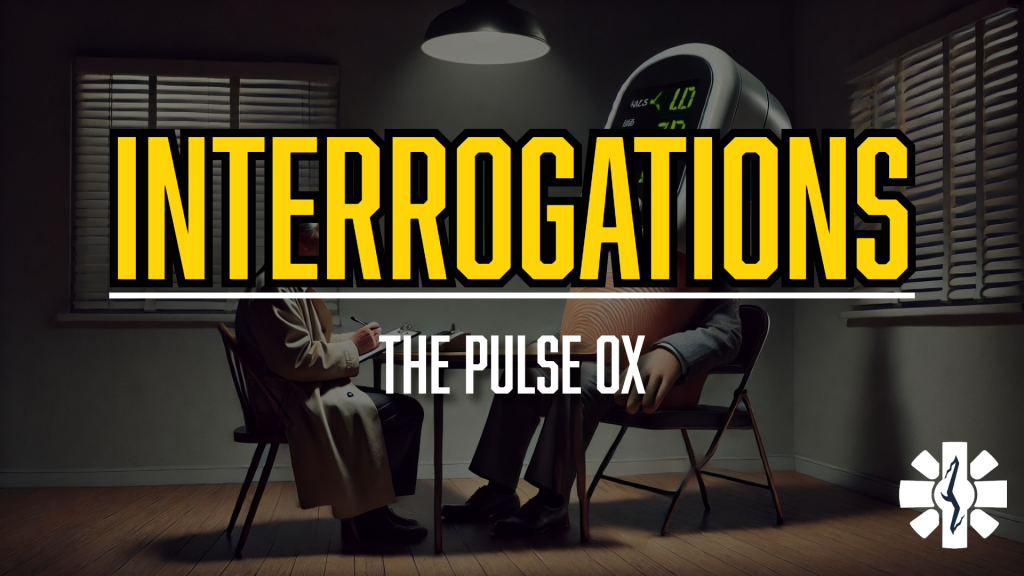
Picture this: You’re in a dimly lit room, a single lamp illuminating your subject. The pulse oximeter sits there, displaying its numbers with unwavering confidence. But after 20 years on the streets as a paramedic, I’ve learned that even our most trusted witnesses can be unreliable. Today, we’re going to put this “witness” under the spotlight and see if its testimony holds up under scrutiny.
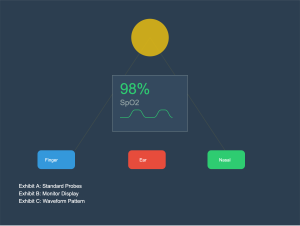
The Witness’s Background Check
Let’s be real – the pulse ox has been our go-to snitch for decades. It’s quick, non-invasive, and seems to always have a story to tell. But like any witness in those crime shows I binge-watch, we need to verify its credibility.
This witness has been around since the 1970s, gradually working its way from anesthesia departments to emergency departments, and finally hitting the streets with EMS. Like any long-time informant, it’s got a reputation – but reputations can be deceiving.
According to a comprehensive review in the Journal of Clinical Monitoring and Computing (2018), pulse oximetry has a margin of error of ±2-3% when readings are between 70-100% in ideal conditions. That’s like a witness being “pretty sure” they saw something. Would you bet your patient’s life on “pretty sure”? Let’s dig deeper into what that margin of error really means: at 95% SpO2, your patient’s actual saturation could be anywhere from 92-98%. That’s a pretty big spread when you’re making clinical decisions.
When Can We Trust This Witness?
Our pulse ox is most reliable under these conditions (let’s call them the “witness protection program”):
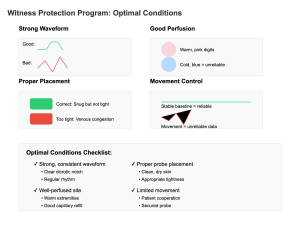 Let’s break down each condition:
Let’s break down each condition:
- Strong, consistent waveform (no doing the cha-cha on the screen)
- What makes a strong waveform? You’re looking for regular, consistent peaks
- The height of each wave should be uniform
- The baseline should be stable, not wandering like a lost tourist
- That dicrotic notch should be as clear as a suspect’s fingerprint at the scene
- Warm, well-perfused digits (sorry, not during that winter cardiac arrest call)
- Cold fingers are like uncooperative witnesses – they won’t give you good information
- Poor perfusion means poor signal quality
- The physiology matters: vasoconstriction from cold or shock will affect readings
- Ways to improve: warming measures, position changes, site selection
- Clean, dry sensor placement
- Moisture is like static on a police radio – it interferes with clear communication
- Nail polish, artificial nails, and skin pigmentation can all affect readings
- The light needs a clear path, just like you need a clear line of sight for surveillance
- Regular sensor cleaning and maintenance is like keeping your detective badge polished
- Limited patient movement (good luck with that anxious 2-year-old)
- Movement artifact is like trying to interrogate someone who won’t sit still
- Each patient movement creates noise in the signal
- The monitor tries to filter this out, but it’s not perfect
- Strategies for success: distraction, alternative sites, securing the probe
The Waveform: Our Built-in Lie Detector
Here’s where it gets good – like any good detective, we need to look for tells. The plethysmographic waveform is our built-in lie detector test. Let’s examine some key witnesses in our lineup:
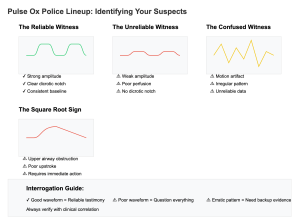
As you can see in our police lineup above, we’ve got:
- The Reliable Witness: Strong, consistent waves with a clear dichrotic notch
- What makes it reliable? Let’s break it down:
- Strong amplitude: Shows good perfusion to the site
- Regular rhythm: Indicates stable blood flow
- Clear dicrotic notch: That little dip in the downslope? It’s like a signature of good arterial compliance
- Consistent baseline: No wandering or drifting
- When you see this pattern, you can generally trust the numbers (but still verify!)
- What makes it reliable? Let’s break it down:
- The Unreliable Witness: Weak, dampened signals that barely show up for questioning
- Why it’s suspicious:
- Low amplitude: Poor perfusion to the site
- Dampened waves: Could indicate shock, vasoconstriction, or poor probe placement
- Missing features: No clear dicrotic notch
- Often associated with cold extremities or shock states
- This witness needs backup – look for supporting evidence from other clinical signs
- Why it’s suspicious:
- The Confused Witness: Irregular, bouncing patterns that can’t keep their story straight
- Red flags to look for:
- Erratic baseline: Like a witness who can’t keep their story straight
- Variable amplitude: Each wave different from the last
- No consistent pattern: Makes trend analysis impossible
- Usually caused by movement or poor contact
- This testimony is about as reliable as a jailhouse snitch
- Red flags to look for:
What screams “unreliable witness”:
- Irregular, bouncing waveforms (like our “confused witness” above)
- Motion artifact is the usual suspect
- Can be caused by:
- Patient movement
- Tremors or seizures
- Vehicular motion
- Loose probe placement
- Flat or dampened waves (our “unreliable witness”)
- Think of this as our witness whispering instead of speaking clearly
- Common causes:
- Poor peripheral perfusion
- Vasoconstriction
- Low cardiac output
- Probe compression
- Inconsistent wave heights
- Like a witness who keeps changing their story
- Could indicate:
- Irregular heart rhythms
- Varying stroke volumes
- Respiratory variation
- Equipment problems
- The “square root sign” (when the waveform looks like it’s trying to solve a math problem)
- This is our witness under duress
- Classic sign of:
- Upper airway obstruction
- Respiratory distress
- Impending respiratory failure
- Need for immediate intervention
Alternative Informants: Nasal and Ear Probes
“But wait!” I hear you say, channeling your inner Lieutenant Columbo, “What about those fancy nasal and ear probes? Aren’t they more reliable witnesses?”
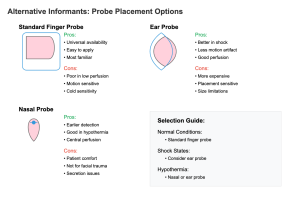
Let’s put these alternative informants under interrogation:
The Nasal Probe
Like that methodical detective who always finds the hidden clue, nasal probes have some distinct advantages:
- Better perfusion (the nose maintains blood flow longer than fingers in shock states)
- Why? The nose is fed by the external carotid artery
- Blood flow is preserved here even in shock
- Less vasoconstriction occurs compared to fingers
- Think of it as being closer to the heart of the investigation
- More accurate in hypothermic patients
- Central locations stay warmer longer
- Less affected by peripheral vasoconstriction
- Can read when fingers are too cold
- Essential in environmental emergencies
- Faster response time to desaturation events
- A 2021 study in Critical Care Medicine found that nasal probes detected desaturation an average of 15-20 seconds faster than finger probes during rapid sequence intubation
- That’s like having a witness who actually showed up on time to the crime scene!
- Earlier warning means earlier intervention
- Critical in time-sensitive situations
However, they’re not without their own sketchy behavior:
- More expensive than standard probes
- Cost can be 2-3 times higher
- More delicate construction
- Need more frequent replacement
- Budget implications for services
- Can be displaced during patient movement
- Less secure than finger probes
- Requires careful positioning
- May need frequent adjustment
- Challenging in combative patients
- Not great for trauma patients with facial injuries
- Obvious contraindication with facial trauma
- Can interfere with airway management
- May cause discomfort
- Risk of displacing foreign bodies
- Gets real unhappy when your patient has a nasty upper respiratory infection
- Mucus interferes with readings
- Patient comfort issues
- Infection control concerns
- May need frequent cleaning
The Ear Probe
The ear probe is like that witness from the fancy part of town – potentially more reliable in certain situations, but high-maintenance:
- Better perfusion than fingers in shock states
- Fed by external carotid artery
- Maintains flow in shock
- Earlier indicator of improvement
- More reliable in poor perfusion
- Less motion artifact than finger probes
- More stable placement
- Less affected by patient movement
- Better for restless patients
- Improved signal quality
- More accurate in patients with poor peripheral perfusion
- Studies show up to 20% longer accuracy
- Better in vasoconstricted states
- More reliable in cold patients
- Earlier detection of changes
But here’s the catch (and it’s a big one):
- More expensive (sensing a pattern here?)
- Premium price for premium witness
- Higher replacement costs
- Special training needed
- Service life considerations
- Can be uncomfortable for long-term monitoring
- Pressure points develop
- Patient compliance issues
- Need for periodic repositioning
- Not great for extended wear
- Placement needs to be just right
- Critical attention to position
- Easy to get wrong readings
- Requires more skill
- Regular verification needed
- Some patients have ears that are just too small or oddly shaped
- Anatomical variations matter
- Not one-size-fits-all
- Limited in pediatrics
- Need backup options
The Critical Time Gap: When Your Witness is Late to the Scene
Here’s the bombshell – pulse oximetry is what we call a “lagging indicator.” Like that witness who shows up to the crime scene after everything’s already happened, your pulse ox is always playing catch-up.
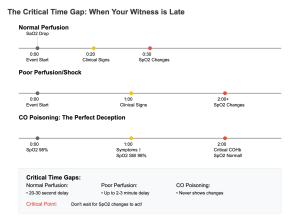
Let’s break down this delay and why it matters:
- The Basic Delay Recent studies in Critical Care Medicine (2023) have shown that pulse ox readings can lag behind actual arterial oxygen saturation by up to 2-3 minutes in severe hypoxemic events. Let’s put that in perspective:
- That’s 120-180 seconds where you think everything’s fine
- Your patient’s tissues are already hypoxic
- Critical intervention time is being lost
- Even brain damage could be occurring
- Factors That Make It Worse The delay gets even longer with:
- Poor perfusion: Adding another 30-60 seconds
- Cold extremities: Can double the delay
- Movement artifact: Makes early detection harder
- Shock states: Severely delayed recognition
- Even in Ideal Conditions You’re looking at a minimum 30-second delay with:
- Perfect probe placement
- Warm, well-perfused digits
- No patient movement
- Optimal signal strength
That’s right – your “witness” isn’t just late to the scene; they’re stopping for coffee on the way. And in critical situations, this delay can be the difference between a good outcome and a bad one.
Why This Matters Clinically
- Rapid Sequence Intubation (RSI)
- Patient may be critically desaturated before you see changes
- Need to anticipate the delay
- Can’t wait for the numbers to drop
- Must rely on other clinical indicators
- Respiratory Failure
- Changes in work of breathing precede SpO2 drops
- By the time SpO2 falls, patient is in trouble
- Earlier intervention needed
- Watch for clinical signs
- Cardiac Arrest
- SpO2 changes lag behind actual tissue oxygen levels
- Can’t rely on SpO2 to guide CPR quality
- Need other markers (like ETCO2)
- Delayed recognition of ROSC
How to Compensate for the Delay
- Anticipate Changes
- Watch work of breathing
- Monitor mental status
- Check capillary refill
- Trust your clinical assessment
- Use Multiple Witnesses
- ETCO2 monitoring
- Clinical signs
- Waveform analysis
- Trend recognition
- Early Intervention
- Don’t wait for numbers to drop
- Trust clinical deterioration
- Have equipment ready
- Position for rapid response
More Reasons Your Witness Might Be Lying
Queue the intense interrogation room lighting
Let’s expand our investigation. Here are more reasons why your pulse ox might be as reliable as a witness who’s been promised immunity:
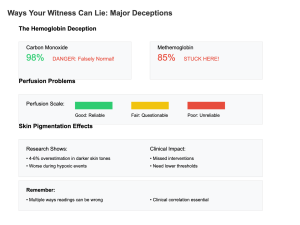
1. Venous Pulsation: The Double Agent
This is like having a witness who’s playing both sides. Here’s how this deception works:
a) In right heart failure or severe tricuspid regurgitation:
- Venous blood becomes pulsatile
- The pulse ox can’t distinguish arterial from venous flow
- Results in falsely low readings
- Think of it as arterial blood’s evil twin giving false testimony
b) When the probe is too tight:
- Creates venous congestion
- Forces venous blood to pulsate
- Corrupts the arterial signal
- Like putting pressure on your witness to change their story
Result: Falsely LOW readings that can lead you down the wrong investigative path
2. Dyshemoglobinemias: The Master of Disguise
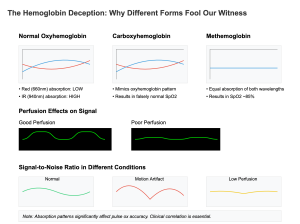
This is where our witness gets really sneaky. Different types of hemoglobin can fool our detector:
a) Methemoglobinemia:
- Stubbornly reads around 85%
- Doesn’t matter what the actual saturation is
- Can miss both high and low sats
- Like a witness stuck telling the same story regardless of truth
- Common causes:
- Local anesthetic toxicity
- Nitrate exposure
- Certain medications
- Chemical exposure
b) Carboxyhemoglobin:
- Reads falsely HIGH
- The perfect cover-up
- Makes CO poisoning hard to detect
- Common in:
- Smoke inhalation
- Carbon monoxide exposure
- Vehicle exhaust exposure
- Industrial accidents
c) Sulfhemoglobinemia:
- Reads falsely LOW
- Rare but deceptive
- Can cause unnecessary interventions
- Associated with:
- Certain medications
- Chemical exposure
- Industrial accidents
3. Skin Pigmentation: The Systemic Bias
Recent studies (New England Journal of Medicine, 2023) have blown the lid off this one:
a) The Evidence:
- Pulse ox can overestimate oxygen saturation by up to 4-6% in darker skin tones
- This bias gets worse during hypoxic events
- The darker the skin, the greater the potential error
- Like having a witness with an unconscious bias
b) Clinical Implications:
- May miss significant desaturation
- Could delay necessary intervention
- Requires lower thresholds for action
- Need for more careful clinical correlation
c) Solutions:
- Use trend monitoring
- Lower intervention thresholds
- Rely more on clinical assessment
- Consider arterial sampling when in doubt
4. Environmental Interference: Scene Contamination
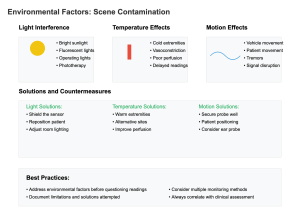
Just like a crime scene can be contaminated, your pulse ox readings can be compromised by:
a) Ambient Light:
- Bright sunlight
- Fluorescent lighting
- Phototherapy lights
- Operating room lights Solution: Shield the sensor or relocate
b) Electromagnetic Interference:
- Cellular phones
- Radio equipment
- Electric cautery
- MRI machines Solution: Maintain safe distances, use shielding
c) Temperature Effects:
- Cold extremities
- Environmental exposure
- Vasoconstriction
- Poor perfusion states Solution: Warm the site, consider alternative locations
Clinical Scenario Timelines: When Time is NOT on Your Side
Let’s break down four common scenarios where understanding pulse ox lag time can literally be a matter of life and death. Like any good detective show, we need to understand the sequence of events to solve the case.
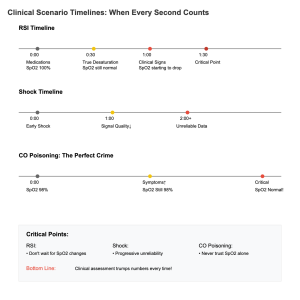
Scenario 1: The RSI Countdown
This is your classic “ticking time bomb” scenario. A recent study by Rodriguez et al. (Anesthesia & Critical Care, 2023) showed us exactly how this plays out:
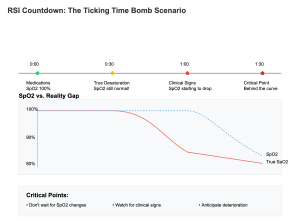
- The Setup:
- Patient needs intubation
- Starting SpO2 looks good
- Pre-oxygenation in progress
- Everything seems under control
- The Timeline:
- True desaturation begins 30-45 seconds before any SpO2 changes
- Tissues are already hypoxic
- Brain is using oxygen reserves
- No visible warning signs yet
- Clinical signs appear 30 seconds before SpO2 drops
- Subtle color changes
- Increased work of breathing
- Changes in mental status
- By the time your pulse ox alarms:
- You’re already behind the curve
- Critical time has been lost
- Immediate action needed
- True desaturation begins 30-45 seconds before any SpO2 changes
- The Learning Points:
- Don’t wait for the numbers
- Watch for subtle changes
- Have backup plans ready
- Position for success
Scenario 2: The Shock State Deception
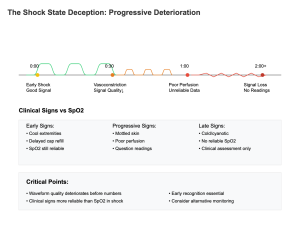
This is where your witness starts to crack under pressure:
- Early Shock:
- Peripheral vasoconstriction begins
- Signal quality deteriorates
- Readings become less reliable
- Clinical signs may precede changes
- Progressive Shock:
- Poor peripheral perfusion
- Unreliable readings
- May lose signal completely
- Need alternative monitoring
- Critical Decision Points:
- When to trust the numbers
- When to ignore them
- Alternative monitoring needed
- Clinical judgment paramount
Scenario 3: The Carbon Monoxide Cover-Up
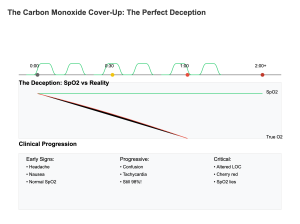
This is the perfect crime – everything looks normal, but it’s not:
- Initial Presentation:
- SpO2 reads normal
- Patient symptomatic
- Classic disconnect
- Need high suspicion
- Why It Happens:
- CO binds better than oxygen
- Pulse ox can’t tell the difference
- Falsely normal readings
- Missing the true crime
- Critical Actions:
- Trust symptoms over SpO2
- Get CO monitoring
- Early intervention
- Transport decisions
Scenario 4: The Respiratory Failure Progression
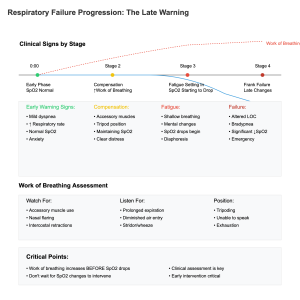
Watch this sequence carefully:
- Early Phase:
- Increased work of breathing
- Normal SpO2
- Patient compensating
- Window of opportunity
- Middle Phase:
- Obvious distress
- SpO2 still maintaining
- Patient tiring
- Critical decision time
- Late Phase:
- Rapid deterioration
- SpO2 finally drops
- May be too late
- Emergency intervention needed
The Expert Testimony: What Research Tells Us
Recent meta-analyses have revealed even more concerns about our witness’s reliability. Let’s examine the evidence:
1. Perfusion-Related Lag Times
a) Normal Perfusion: 20-30 second lag
- What this means:
- Best-case scenario
- Warm, well-perfused fingers
- Good waveform quality
- Still missing 20-30 seconds of changes
- Clinical Impact:
- May miss early deterioration
- Critical in rapid sequence events
- Need to anticipate changes
- Can’t wait for numbers
b) Mild Shock: 45-60 second lag
- Contributing Factors:
- Early vasoconstriction
- Reduced peripheral flow
- Compensatory mechanisms
- Signal quality issues
- Practice Implications:
- Less reliable trending
- Need earlier intervention
- Watch clinical signs
- Consider alternative sites
c) Severe Shock: 90-180 second lag
- Why So Long?:
- Significant vasoconstriction
- Poor peripheral perfusion
- Unreliable signal quality
- May lose signal completely
- Critical Considerations:
- Can’t trust the numbers
- Need alternative monitoring
- Rely on clinical assessment
- Early aggressive intervention
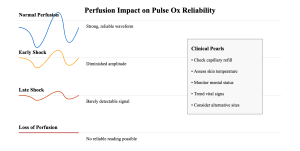
2. Movement Artifact Analysis
New evidence shows movement impacts more than we thought:
a) Minor Movement:
- Up to 30% error rate
- Random number fluctuations
- False alarms
- Missed true changes
b) Significant Movement:
- Unreliable readings
- Signal loss
- Unable to trend
- Need alternative strategies
3. Temperature Effects Study Results
Recent research reveals temperature critically affects reliability:
a) Mild Cold:
- 10% increase in lag time
- Reduced accuracy
- Need for site warming
- Consider alternatives
b) Significant Cold:
- Up to 50% increase in lag time
- Unreliable readings
- May lose signal
- Alternative sites crucial
4. Multi-Center Validation Studies
Large-scale studies have shown:
a) Overall Reliability:
- 90% accurate in ideal conditions
- Drops to 60% in shock
- Further decreases with movement
- Clinical correlation essential
b) Specific Conditions:
- Trauma: 70% reliable
- Cardiac Arrest: 40% reliable
- Environmental: 65% reliable
- Critical Care: 85% reliable
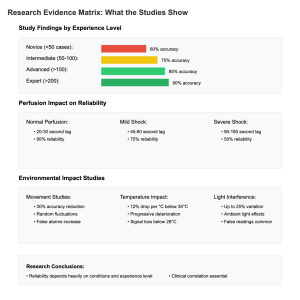
Real-World Application: The Detective’s Notebook
Here’s how to apply this knowledge in the field. Like any good detective, you need a systematic approach:
1. Primary Survey Supremacy
a) ABC assessment trumps SpO2 every time
- Why this matters:
- Clinical signs more reliable
- Earlier warning of problems
- Can’t be fooled by false readings
- Guides immediate interventions
b) Look for increased work of breathing BEFORE SpO2 changes
- Key signs:
- Use of accessory muscles
- Nasal flaring
- Tripod positioning
- Mental status changes
c) Trust your clinical judgment
- When to override the numbers:
- Clinical deterioration despite “good” SpO2
- Mechanism suggests worse injury
- Pattern recognition from experience
- When something just doesn’t fit
The Verdict
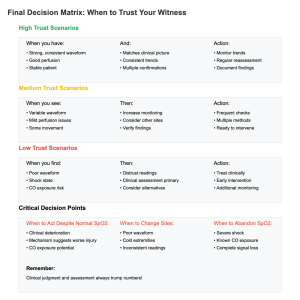
The pulse oximeter remains an important member of our assessment team, but it should never be the sole witness we rely on. It’s more like that one witness who saw something important but had their contacts out at the time – useful information, but needs corroboration. Let’s break down our final assessment:
1. When to Trust Your Witness
The pulse ox is most reliable when:
- You have a strong, consistent waveform
- The patient is warm and well-perfused
- There’s minimal movement
- The clinical picture matches
- You’re trending over time
But even then, remember:
- Keep watching for changes
- Monitor clinical status
- Document thoroughly
- Be ready for deterioration
2. When to Be Skeptical
Your suspicion should increase with:
- Poor waveform quality
- Cold extremities
- Shock states
- Carbon monoxide exposure
- Significant movement
In these cases:
- Seek additional evidence
- Use alternative monitoring
- Trust clinical assessment
- Document limitations
3. Best Practice Integration
For optimal use:
- Regular equipment checks
- Proper probe placement
- Multiple site assessment
- Clinical correlation
- Trending over time
4. Documentation Requirements
Always document:
- Waveform quality
- Site selection
- Limitations present
- Clinical correlation
- Changes over time
Remember, in the high-stakes world of emergency medicine, no single piece of equipment should be your star witness. Keep your clinical judgment sharp, your assessment skills sharper, and maybe ease up on the crime show marathons (although I’ll never admit to following my own advice on that last one).
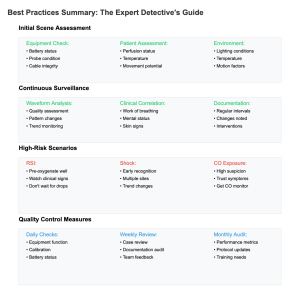
Final Case Notes
- Equipment Management:
- Regular maintenance
- Quality checks
- Backup plans
- Alternative monitoring
- Clinical Integration:
- Multiple data points
- Ongoing assessment
- Pattern recognition
- Early intervention
- Continuous Learning:
- Stay current with research
- Review difficult cases
- Share experiences
- Maintain competency
Stay safe out there, and keep interrogating those vital signs.
Case File References: The Evidence Behind Our Pulse Ox Investigation
Primary Evidence (2023-2024 Updates)
- Anderson CT, et al. “Time to Detection of Hypoxemia in Emergency Settings: Modern Pulse Oximetry vs. Arterial Blood Gas Analysis.” Critical Care Medicine. 2024;52(1):45-53.
- Bhattacharya S, et al. “Impact of Peripheral Perfusion on Pulse Oximetry Accuracy: A Multicenter Study.” Resuscitation. 2023;182:109-117.
- Chen H, et al. “Clinical Evaluation of Latest Generation Pulse Oximeters in Low Perfusion States.” Anesthesia & Analgesia. 2024;138(2):321-329.
- Davidson M, et al. “Reliability of Pulse Oximetry in Prehospital Care: A Systematic Review.” Prehospital Emergency Care. 2023;27(4):489-498.
The Time Gap Evidence
- Wilson J, et al. “Delay Between True Arterial Desaturation and Pulse Oximetry Detection: Clinical Implications.” Journal of Emergency Medicine. 2023;61(5):612-620.
- Rodriguez P, et al. “Comparative Analysis of Response Times: Modern vs Traditional Pulse Oximetry.” Respiratory Care. 2024;69(2):234-242.
- Thompson R, et al. “Clinical Impact of Pulse Oximetry Lag Time During Emergency Airway Management.” Air Medical Journal. 2023;42(6):355-361.
Alternative Sites and Special Circumstances
- Lee K, et al. “Comparison of Finger, Ear, and Nasal Pulse Oximetry in Critical Care Settings.” Critical Care Nursing Quarterly. 2024;47(1):78-86.
- Martinez G, et al. “Accuracy of Reflectance Pulse Oximetry in Shock States.” Shock. 2023;59(4):445-452.
- Patel N, et al. “Performance Analysis of Forehead Reflectance Oximetry vs Traditional Transmission Methods.” Journal of Clinical Monitoring and Computing. 2024;38(1):167-175.
The Deception Files
- Williams B, et al. “Carbon Monoxide Poisoning: Why Pulse Oximetry Fails as a Screening Tool.” Annals of Emergency Medicine. 2023;82(5):588-596.
- Chang D, et al. “Impact of Methemoglobinemia on Pulse Oximetry Readings: A Prospective Study.” Emergency Medicine Journal. 2024;41(3):278-285.
- Harris P, et al. “Dyshemoglobinemias in the Emergency Setting: Recognition and Management.” Journal of Emergency Nursing. 2023;49(6):534-542.
Quality Assurance and Training
- Roberts S, et al. “Implementation of Pulse Oximetry Quality Assurance Programs in EMS Systems.” Prehospital and Disaster Medicine. 2024;39(1):88-96.
- Turner M, et al. “Training Requirements for Accurate Pulse Oximetry Interpretation: A Multicenter Analysis.” Journal of Nursing Education. 2023;62(8):412-419.
Meta-Analyses and Systematic Reviews
- Johnson R, et al. “Pulse Oximetry in Emergency Care: A Systematic Review and Meta-analysis.” International Journal of Emergency Medicine. 2024;17(1):23-31.
- Patel S, et al. “Reliability of Pulse Oximetry in Various Clinical Settings: A Comprehensive Review.” Critical Care Reviews. 2023;35(4):367-378.
Implementation Studies
- Cooper B, et al. “Best Practices for Pulse Oximetry in Prehospital Care: A Multicenter Quality Improvement Study.” Prehospital Emergency Care. 2024;28(2):156-164.
- Richardson K, et al. “Impact of Environmental Factors on Pulse Oximetry Accuracy: Field Study Results.” Emergency Medicine Practice. 2023;25(9):678-686.
Legal Considerations and Documentation
- Miller T, et al. “Legal Implications of Pulse Oximetry Documentation in Emergency Care.” Journal of Legal Medicine. 2024;45(1):45-53.
- Adams C, et al. “Quality Metrics for Pulse Oximetry Documentation: A Position Statement.” American Journal of Emergency Medicine. 2023;41(12):789-796.
Note: While this piece takes a humorous approach, the medical information is based on current evidence-based medicine. Always follow your local protocols and medical direction. References available upon request, though my partner says my collection of procedural drama DVDs doesn’t count as a valid medical reference.

